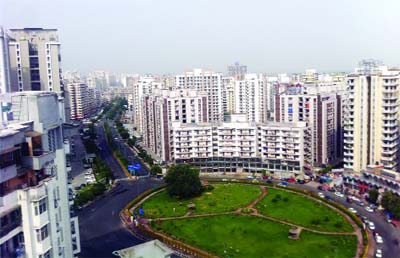It is home to the new kid on the block in Indian politics — the Aam Aadmi Party. With AAP joining the electoral fray, Ghaziabad parliamentary constituency is set for a four-
cornered battle this poll. Rated second in the list of the world’s fastest growing cities in terms of urbanisation by a global think tank in 2011, Ghaziabad continues to grapple with problems of intermittent power and water supply and a rising crime graph. This burgeoning constituency comprises the five Assembly segments of Sahibabad, Muradnagar, Dhaulana, Ghaziabad and loni. loni and Sahibabad, the two seats neighbouring the national Capital, have witnessed a sharp increase in voter strength with a record of over 1 lakh added to the existing electoral rolls.
One of the oldest industrial townships in Uttar Pradesh, Ghaziabad also has a significant population of Thakurs, Vaishya and Brahmins, who have traditionally voted for the BJP. The party won the seat in 1998, 1999 and wrested it from the Congress in 2009. The lok Sabha seat significantly enough has been captured by an ‘outsider’ on several occasions. This constituency holds the record of electing a Dalit leader from Aligarh for the general category seat. Congress’ Budh Priya Morya was not only an ‘outsider’ but a Dalit leader from Khair town of Aligarh. He defeated the then juggernaut Prakash Vir Shastri of Bijnor in the 1971 polls.
SAHIBABAD Assembly constituency has recorded a sharp rise in votes from about 6.78 lakh voters in March 2012 to 7.69 lakh voters in 2014. The Capital’s border constituency is home to migratory population from across the country; several slums and huge hutments have emerged alongside the border of the national Capital whose over a lakh residents commute to the Capital daily for work. Earlier this seat was the hub of industrial labour where noted theatre personality and social activist Safdar Hashmi was killed while staging a play. The lower court convicted about 50 rioters, who allegedly killed him at the behest of industrialists. After the shutdown of major industrial units following a labour uprising, the entire population depends on the national Capital in the unorganised sector to eke out a living.
Another important feature is the mushrooming of residential towers where catchment of middle class executives has settled down in the outskirts of the Capital. Young professionals who work in Delhi but on account of cheaper accommodation stay here complain of poor connectivity. None of the parties so far have been able to address the issue of traffic chaos on NH24, a vital link between Ghaziabad and Delhi.
These two groupings of migratory population have two different dimensions to their political predilection. Earlier the BSP won this seat but this time with AAP in the picture, slum dwellers are predisposed to AAP. The executive class in residential towers though seems inclined towards the BJP. Farmers, another significant part of the voter mix, have expressed their disappointment with both the SP Government in the State and the UPA regime at the Centre.
Another important segment of Ghaziabad parliamentary constituency is the lONI Assembly seat which comprises 4,01,142 voters out of which Muslims and Dalits are a major chunk along with Gujjars. This seat has also shown an increase of about 1 lakh voters in the past one year after commencement of State Assembly elections in 2012. In the last election, Rajnath Singh trailed behind in this seat.
The GHAZIABAD Assembly segment with 3,77,450 voters has a mixed population of Dalits, Vaishyas, Muslims, Punjabi migrants and Brahmins, mainly from the trading community. A major chunk of Muslim population falls under this constituency. Presently the seat is retained by BSP’s Suresh Chand Bansal. Traditionally, Punjabis were the votebank of the BJP but this time, the community seems somewhat tilted towards Raj Babbar from the Congress. Interestingly, after the inception of AAP, the traditional Congress votebank from Kaila Bhatta — mainly predominated by Muslims — seems inclined towards AAP which could rain on Congress candidate Raj Babbar’s parade.
Sensing the gravity, Raj Babbar has thrown his weight behind this community while the BJP seems self-assured with its Vaishya vote. In MURADNAGAR Assembly segment of Ghaziabad parliamentary constituency, there are 3,86,566 voters. Presently the seat is retained by the BSP. It contains 3,86,566 votes. The Muradnagar Assembly segment covers the new-fangled Ghaziabad comprising district headquarters, civil court DM and upscale areas like Raj Nagar and Kavi Nagar.
DHAUlANA is the fifth Assembly segment of Ghaziabad parliamentary seat. It contains 94,999 voters, mainly Rajput and Raghar (Muslims) Rajputs. The Muslims and Hindu Rajputs are the main voters of the area with a small segment of Dalits. In 2009, Rajnath Singh won this seat by a huge margin. Retired Army chief General VK Singh is also eying this Thakur belt. But AAP’s Shazia Ilmi is focussed on not just the Muslims but the young/first-time voters cutting across caste lines.


























